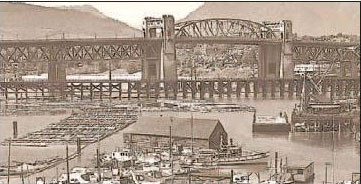Matthew Little
Province

There was going to be a rail crossing built under the bridge, but it was cancelled when the Depression hit.

The Burrard Street Bridge opened on July 1, 1932. It had a reported cost of $3 million and was opened by Mayor Louis Taylor.

An archive photo shows the bridge in 1948.
– On the bridge’s opening day, the Vancouver Daily Province showed huge crowds waiting to walk across. The paper had ads for $2 perms and an all-day, round-trip sea-and-rail excursion to Brandywine Falls for $2.50.
– There is a secret stairwell a third of the way from the south end of the bridge that goes down to the Burrard Civic Marina. It was closed because people were living there and someone got mugged.
– The bridge is designed with sleek lines in the Art Deco style. The web of steel that crosses above the centre of the span is hidden from oncoming traffic by the bridge’s signature overhead galleries.
– Bridge engineer and project manager Major J.R. Grant came up with the torches at either end. They were modelled after First World War trench heaters, a tribute to Allied prisoners.
– The heads of the two men atop prows of small boats on the galleries are Capt. George Vancouver and Sir Harry Burrard, a naval friend of Vancouver‘s.
– Art Deco arches hide big steel trusses that protrude from under the bridge. The pillars were built twice the needed size, to emulate mountains.
– The bridge was the first to cross False Creek high enough so ships could travel underneath. An RCAF seaplane wowed the opening-day crowds by flying under the bridge.
– Current plans call for cantilevered “outrigger” bike lanes to be added on the sides for extra bicycle and pedestrian traffic. Opponents say the lanes will ruin the bridge’s Art-Deco styling. The plan is still being developed.
– Because of the “outrigger” plan, the bridge has repeatedly topped Heritage Vancouver’s Top 10 Endangered Sites list.
– The bridge and English Bay can be viewed by one of Canada‘s oldest webcams, mounted in a Telemark Systems office window since 1996. Visit www.katkam.ca to check it out.
– The bridge has been in a TV pilot for the show It’s True, a music video and the movies Shiny New Enemy, Kill Me Later and The Burial Society.
– The Squamish Nation’s plan to erect five billboards at the south end of the bridge is an ongoing controversy. The plan calls for five 11-by-three-metre rotating panel billboards. Each billboard can generate up to $50,000 a year. The plan sparked opposition from residents and city councillors.
– In June 1996, one of the bridge’s six lanes was converted to a bike lane for a week as an experiment. Drivers, irate at the 15-minute delay, flooded city hall with complaints and planned future tests were
cancelled.
– During the test an average of 8,840 fewer cars crossed while 870 more bikers, 200 more walkers and 240 more transit users crossed.
– The bike lane controversy erupted again in 2005, when council voted to turn two lanes into dedicated bike lanes. The project was delayed until after the next civic election, but Mayor Sam Sullivan cancelled it.
